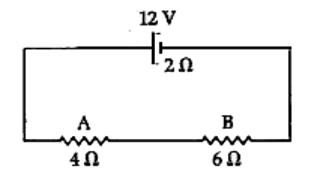Consider a series combination of two resistors of resistances 10Ω and 40Ω across which a potential difference of 5 V is applied. Find the current in the circuit and the potential difference across each resistor.Solution in Marathi
Step by step video & image solution for Consider a series combination of two resistors of resistances 10 Omega and 40 Omega across which a potential difference of 5 V is applied. Find the current in the circuit and the potential difference across each resistor. by Physics experts to help you in doubts & scoring excellent marks in Class 9 exams.
Updated on:21/07/2023Topper's Solved these Questions
Similar Questions
Fill in the blanks:
The coulomb is the SI unit of………….
View SolutionComplete the sentences and explain them:
The minimum distance between the start and finish points of the motion of an object is called the ........ of the object.
View SolutionConsider the circuit shown in figure.Find (a) the current in the circuit, (b) the potential drop across the (5Ω)resistor,(c )the potential drop across the 10(Ω)resistor.(d)Answer the parts (a),(b)and (c )with reference to figure.

View SolutionDraw a circuit diagram of an electric circuit containing a cell, a key, an ammeter, a resistance of 2Ω in series with a combination of two resistors (4Ω each) in parallel and a voltmeter across the parallel combination. Will the potential difference across the 2Ω resistor be the same as that across the parallel combination of 4Ω resistors ? Give reason.
View SolutionA resister of 80 Omega is connected to a cell and the potential difference across the resistor is 40 V. Then the amount of current that flows through the given resistor is "_____" A.
View SolutionThree resistors of 10 Ω, 15 Ω and 20 Ω are connected in series in a circuit. If the potential drop across the 15 Ω resistor is 3 V, find the current in the circuit and potential drop across the 10 Ω resistor.
View SolutionDraw a circuit diagram of an electric circuit containing a cell, a key, an ammeter, a resistance of 2Ω in series with a combination of two resistors (4Ω each) in parallel and a voltmeter across the parallel combination. Will the potential difference across the 2Ω resistor be the same as that across the parallel combination of 4Ω resistors ? Give reason.
View SolutionConsider the circuit shown in figure.Find (a) the current in the circuit, (b) the potential drop across the (5Ω)resistor,(c )the potential drop across the 10(Ω)resistor.(d)Answer the parts (a),(b)and (c )with reference to figure.

View SolutionSolve: Two resistors having resistance of 16 and 14 are connected in series, if a potential difference of 18 V is applied across them, calculate the current flowing through the circuit and the potential difference across each individual resistor
View SolutionThree resistors 10Ω, 20Ω and 31Ω are connected in series combination.
When this series combination is connected to 12V supply, by neglecting the value of internal resistance, obtain potential difference across each resistor
View SolutionA battery of e.m.f. 12 V and internal resistance 2 Ω is connected with two resistors A and B of resistance 4 Ω and 6 Ω respectively joined in series.

Find The potential difference across 6 Ω Resistor.
View SolutionIn the circuit diagram given below, a cell of 9 V and internal resistance of 0.5 (Omega) is connected across a resistor A of 2Omega in series and two resistors of 2Omega and 6Omega in parallel. Find The potential difference across the terminals of the cell.
View SolutionDraw the circuit diagram to measure the potential difference across a 10Ω resistor when it is connected in series with a 20Ω resistor and a 6 V source.
View SolutionA resistor of 6 Omega is connected in series with another resistor of 4 Omega . A potential difference of 20 V is applied across the combination. Calculate : the current in the circuit,
View SolutionA resistor of 6 Ω is connected in series with another resistor of 4 Ω. A potential difference of 20 V is applied across the combination. Calculate :
the potential difference across the 6 Ω resistor.
View Solution
